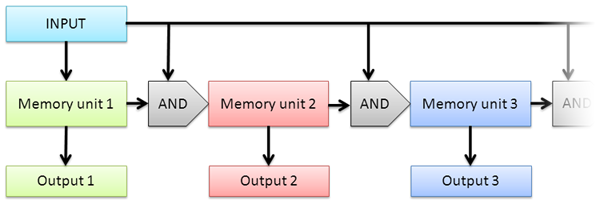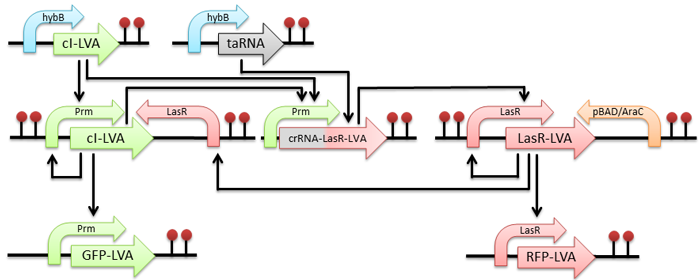Team:Groningen/Project
From 2011.igem.org
Project description - circuit design and functionality
The aim of our project is to create a genetic device that will be able to count and memorize the occurrences of an input signal. This functionality will be achieved by the utilization of autoinducing loops, that will act as memory units, and interfering taRNA-crRNA system, which will act as an AND gate. Each increase of the counter will result in a different state of the system, that will result in an output signal.
The design of the device is modular. This means that both the input signal and the output signals can be changed freely, without disturbing the functionality of the memory system. Also, the design allows implementation of any number of memory units, as the AND gate design allows for a nearly hassle-free extension of the system, provided enough functional memory units.
Because of that, the range of applications of our system can vary from the bacteria being used as a memory system of a Turing complete machine, through bacteria used as biosensors measuring the number of occurrences of an event in a ecosystem or in a process, to bacteria that can perform multi-step bioconversions sequentially all by themselves and without the need of changing them to another strain.
Figure 1 - The outline of the project.The first occurrence of the input signal triggers the first memory unit (which consists of an autoinducing loop and a jammer-based off switch) to start. The first memory unit starts triggering the first AND gate. The second occurrence of the input triggers the AND gate. If the first memory unit is running, the AND gate triggers the second memory unit (which also consists of an autoinducing loop and a jammer-based off switch) to start. The second module starts triggering the second AND gate and represses the first module with the use of the jammer-based off switch. This process can be continued, if more autoinducing loops are provided. During operation, the system produces an output which depends on the current running memory unit.
Figure 2 - The design of the circuit. We have chosen to use the hybB operon promoter as our input signal. This promoter reacts, among other signals, to a cold shock.
The first occurrence of the input signal causes the cell to produce cI-LVA protein (which activates the modified Prm promoter) and taRNA (which has no effect before it degrades). The cI-LVA activates three operons: first, which is an autoinducing loop creating more cI-LVA protein, second which produces signal - GFP, and third which produces the crRNA-LasR-LVA transcript. This transcript is self-inhibiting itself.
The second occurence of the input signal produces taRNA again, which now can bind to the crRNA part of the crRNA-LasR-LVA transcript. It activates the transcript and leads to creation of LasR-LVA protein. This protein activates two operons: first which is an autoinducing loop creating more LasR-LVA protein and second which produces signal - RFP. The third effect of LasR-LVA protein is shutting down of the first autoinducing loop via a jammer - LasR promoter placed on the anti-sense strand of DNA after the operon.
The system can be reset to the basic state by addition of arabinose to the medium, which shuts down the second autoinducing loop via a jammer - pBAD/AraC promoter placed on the anti-sense strand of DNA after the operon.
Project description - modeling
| Home | Team | Official Team Profile | Project | Parts Submitted to the Registry | Modeling | Notebook | Safety | Attributions |
|---|
 "
"


